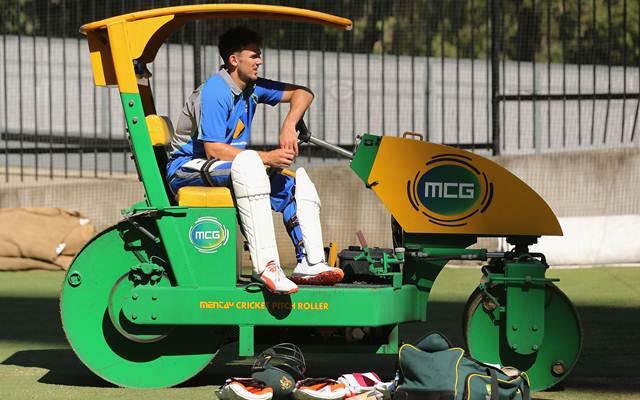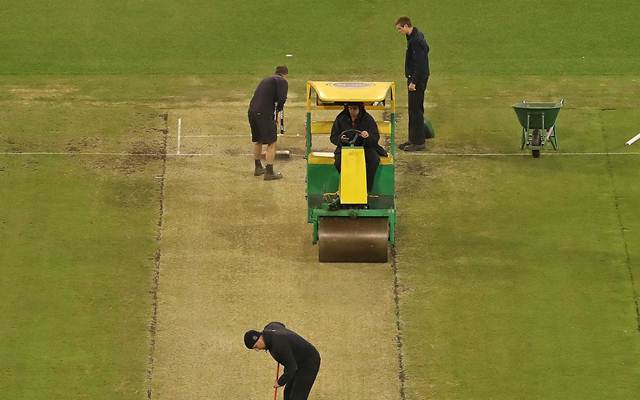How heavy and light rollers impact a game of Test cricket
It’s evident that the age-old rollers have been an integral part of the game since the very inception of it.
5 Min Read


The game of cricket is one that never fails to surprise us; a game full of tangible splendour as well hidden intricacies. While most of us are bedazzled by the runs scored and the number of bails clipped off the stumps, we tend to forget the one true hero responsible for bringing a match alive. The pitch. The 22-yards. The turf that makes or breaks. The boundaries smashed, the wickets scalped, the bouncers bowled: the genesis lies in the pitch.
Now, apart from the factors of grass cover and soil composition, what makes a pitch playable (or unplayable, for that matter) depends primarily on the kind of roller that’s used on it. Those who are in the habit of catching the pre-match sessions ahead of Test matches may have witnessed the monstrous machines being operated on the playing pitch but the significance of the action has been a recipient of very less attention through the ages.
Types of Rollers
The rollers are essentially of two types- Heavy and Light. While the relevance and uses of the roller have been debated for long, it’s an established fact that as an instrument in the cricketing field, it has undergone a sea change over the years.
Back in the 1930s, the heavier versions were found in plenty, which needed one or more groundsmen to manoeuvre the roller on the pitch by dragging it back and forth. Notably, it was in August 1938 when England thrashed Australia by an innings and 579 runs after having put up a humongous total of 903/7. An iconic picture of the Test match shows Bosser Martin, who was the groundsman at The Oval with his heavy roller which, according to an article in The Guardian by eminent Cricket commentator and writer, Mike Selvey, had worked on the pitch “till the surface resembled concrete”. However, technology has paved way for motorized versions of the tool to replace the manually handled ones.
Light Roller
Coming to the technicality of it, the two breeds of rollers are meant for different scenarios. A light roller is typically used on a soft pitch in order to smooth out unevenness. A soft pitch, in particular, is vulnerable to having dents made on it as the ball lands and as the day progresses, these dents harden under the harsh sunlight, making the batsman confront uneven, at times even wayward, bounce off the track.
Heavy Roller
The heavy roller, in contrast, is brought into play in order to flatten out the pitch like a rolled out ‘chapati’. Although there are myths of a dry pitch cracking under the pressure of a heavy roller, it has been dispelled by most experts, who have termed ‘cracking due to heavy rollers’ a rare phenomenon. Interestingly, the use of a heavy roller after the start of play had been banned for the period of 2010-2012 in County Cricket but was brought back in the 2013 season.
Who gets to choose the roller type in a match?
A common question arises here: Who gets the say in when and which type of roller is to be employed upon the pitch? Barring the first day of any Test match, it is the batting team captain who dictates the rolling conditions. According to the Law 10. (a) of the ICC Rules of Cricket written and interpreted by the Marylebone Cricket Club (MCC), which entails “Preparation and Maintenance of the Playing Area”: “During the match the pitch may be rolled at the request of the captain of the batting side, for a period of not more than 7 minutes, before the start of each innings, other than the first innings of the match, and before the start of each subsequent day’s play.” Further, Law 10. (c) elucidates on the ‘Choice of rollers’ as: “If there is more than one roller available the captain of the batting side shall choose which one is to be used.”

Pros and cons of the 2 types of rollers
Now, in order to deconstruct how the batting side captain is expected to make a decision, the team composition of both sides needs to be taken into consideration. First up, the moment an innings concludes and as the fielding side walks off, the groundsman enquires of the captain on the nature of the roller he requires and the skipper either raise a flat palm high in the air or low to the ground to signal a heavy or a light one, respectively.
If a heavy roller is used on the pitch, the soil tends to get compressed making the surface rock-hard. This hardly leaves any cracks to be exploited by the spinners and it’s the pacers who feast on such wickets, owing to the consistent, zippy bounce. However, this may act as a double-edged sword by working in favour of the batting side if the majority of their batsmen are fluent in facing pacers as the ball comes onto the bat quicker and better, after having landed on a pitch as sturdy as cast cement.
On the other hand, as former English cricketer, Steve James observed, using only a light roller at a stretch would present the batsmen with “a cocktail of uneven bounce and lateral movement”. James, in one of his columns for The Telegraph, summarised the seasons where heavy rollers were banished as, “Some of the cricket was dreadful. Sides were often compelled to bat first and hope they could muster 200 on a damp pitch, in the knowledge that the dent-riddled surface would be even more treacherous by the time of the fourth innings”.
It’s evident that the age-old rollers have been an integral part of the game since the very inception of it. Today, when cricket is at a juncture where the glitz of the limited-overs format is gaining momentum rapidly and has almost reached an uncomfortably overpowering stature, the nitty-gritty of Test cricket, like the judicious employment of rollers, need to be scrutinized and ascertained on a regular basis by cricketers, governing bodies and groundsmen alike. After all, “The Rolling Stones” of Cricket constitute the very core of our beloved game!
Download Our App